Any discussion of the merits of cycling infrastructure in the UK will inevitably throw up the phrase “what about the Netherlands?” And it was precisely this sentiment that resonated with us earlier this year as we pondered where to go cycle touring this time. Having explored that other cycling paradise Denmark (and northern Germany) on my last continental bike tour, seeing how the Low Countries stack up in cycling terms had to be done.
Planning
One of the many things I like about cycle touring is that you can take a modular approach to planning. Thus, in the hated cold, grey month of February, we plucked a week or so in the late summer out of the calendar and booked the ferry crossing – a return trip between Newcastle and Ijmuiden (Amsterdam) – and left it at that for a while. A couple of months before departure, we started looking at the map: what’s feasible in the time we’ve given ourselves? What’s worth seeing? Which way do we turn when we get off the boat? If we turn right, we can cross into Belgium and compare & contrast a second country. Cool, let’s do that. So once the provisional route was outlined, we firmed up a couple of key stops: hostel in Bruges as the mid-point, hotel in Amsterdam for the final night, with everything else to be decided on the hoof as we travel. Semi-structured, if you will.
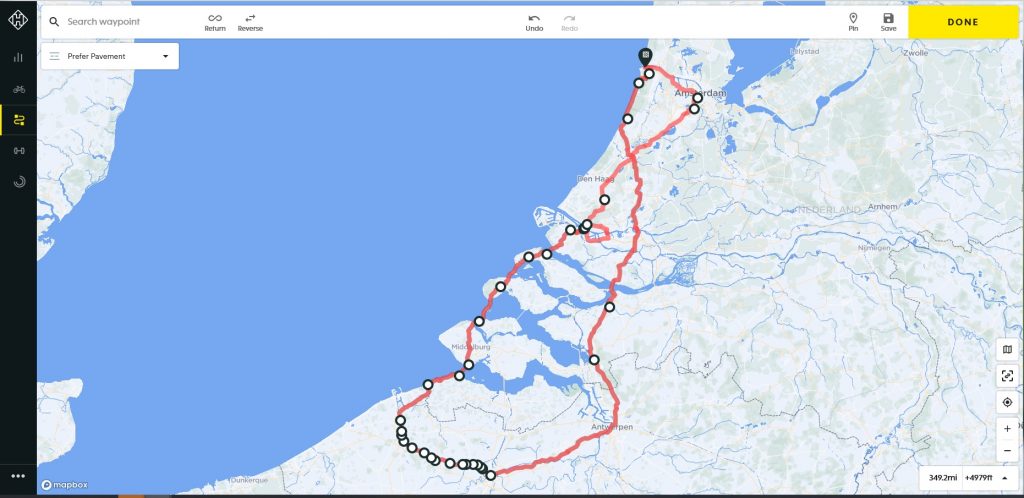
Provisional tour route.
Packing
As departure day approached, we feverishly checked the weather apps for each of the places we would pass through – Amsterdam, Antwerp, Bruges, Delft – and it wasn’t looking good. Rain forecast for every place on every day we were planning to be there. So we had to pack accordingly:
- 3 changes of cycling jerseys/bottoms (2x capri-length plus one short in hope of a little sun!), waterproof jacket & trews, overjersey, gilet, mitts, caps
- Change of clothes for off the bike plus quilted jacket & city shoes & Crocs (sic!)
- Tent (which we thankfully split between us – one of the many benefits of touring as a couple!), sleeping bag, mat
- Camping stove, pots & cutlery, gas canister
- Fallback food lest no vegan options (Huel pasta bolognese, Began oat cappuccino sachets)
- Bike tools and spares
- Phone, power bank (I treated myself to a no-nonsense, extra-powerful one from Anker to be sure none of my probably excessive gadgets runs out of juice), wall charger & euro adapter, cables, Hammerhead (Karoo 1) GPS navigation device plus paper maps just in case, GoPro camera to capture all the action, Garmin watch (see what I mean about the gadgets!)
- Toiletries, suncream (despite the time of year, as a ginger I can get sunburnt in most weather conditions!)
- Random other oddments
So once again: heavy bikes!
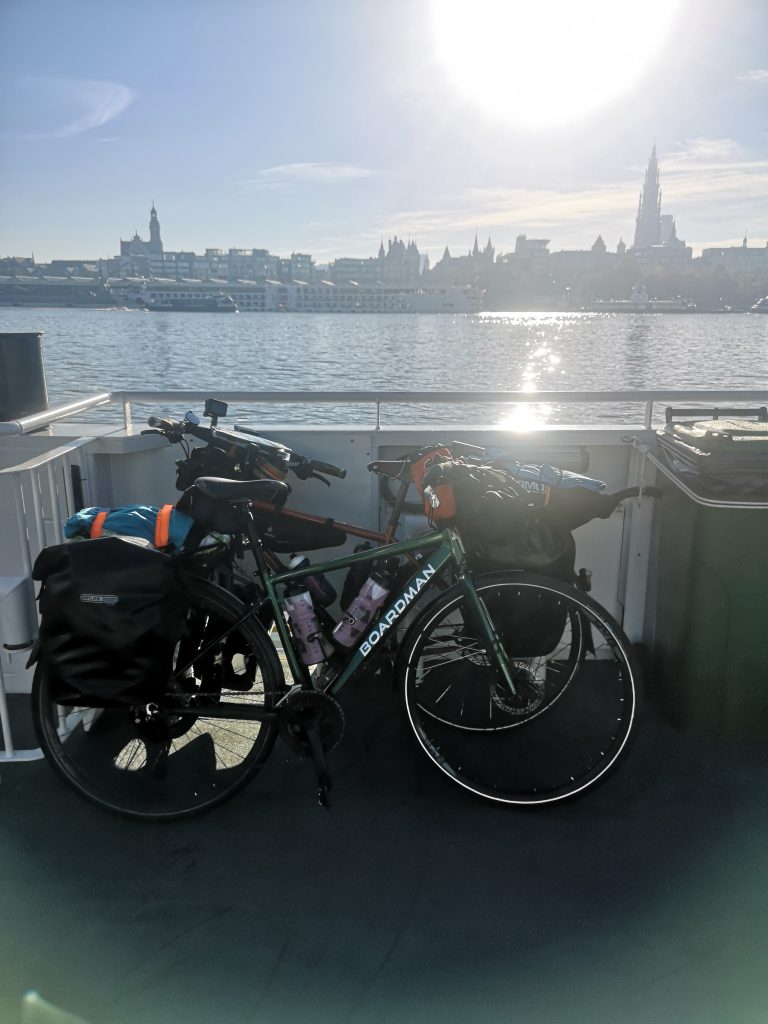
Laden bikes, here on the Antwerp ferry.
Getting there & back
Never say never, of course, but neither of us has flown for years and we’d rather keep it that way. So train and ferry was chosen as the favoured mode of transport, with a direct train from Manchester to Newcastle (plus – finally – bike reservations!) bookable via the Transpennine Express website. As mentioned, the ferry was sorted long ago via the DFDS website, which for its part makes booking bikes very easy for a nominal charge.
On the day of departure our direct train was cancelled so we ended up improvising a connection via York (which included wrestling our bikes into the (probably illegal) bike closets LNER grudgingly provide for bikes. From Newcastle it’s a pleasant, mostly traffic-free ~9-mile cycle along the banks of the Tyne (indeed, the final leg of the Hadrian’s Cycleway) to the ferry port.

Bikes jammed into those bloody upright cycle hangers. Grrr.
Check-in to the ferry was very straightforward & we were quickly on board, settled into the cabin and in the pub. Then an early night after dinner (see “Vegan food” below) in anticipation of the early start the next day.
Disembarking was similarly uncomplicated, but as bikes are treated as vehicles, we were made to stand in the already pouring rain at the customs post as I awaited my Brexit benefit of a stamp in my UK passport.
The return leg was even smoother – without the train cancellation – so (after a gruff exchange with the conductor about manhandling our bikes into yet more constricted vertical hangers in the TPE train) we enjoyed a calm, direct, 2.5 hour train ride back to Manchester.
Compared with flying with a bike, train/ferry is significantly less of a ball-ache: you roll your bike on and off with no need to dismantle it, you don’t have the faff of sourcing/storing flight boxes/bags, nor do you emit an unconscionable amount of CO2 (for those who give a toss). Yes, it’s slower, but you can stretch your legs, have a drink and a buffet meal, watch a dodgy covers band (“What’s Up”, ours was called!) or the “Troubadour” (busker) and get something resembling a horizontal night’s sleep. Just treat it as part of the holiday and enjoy the voyage.
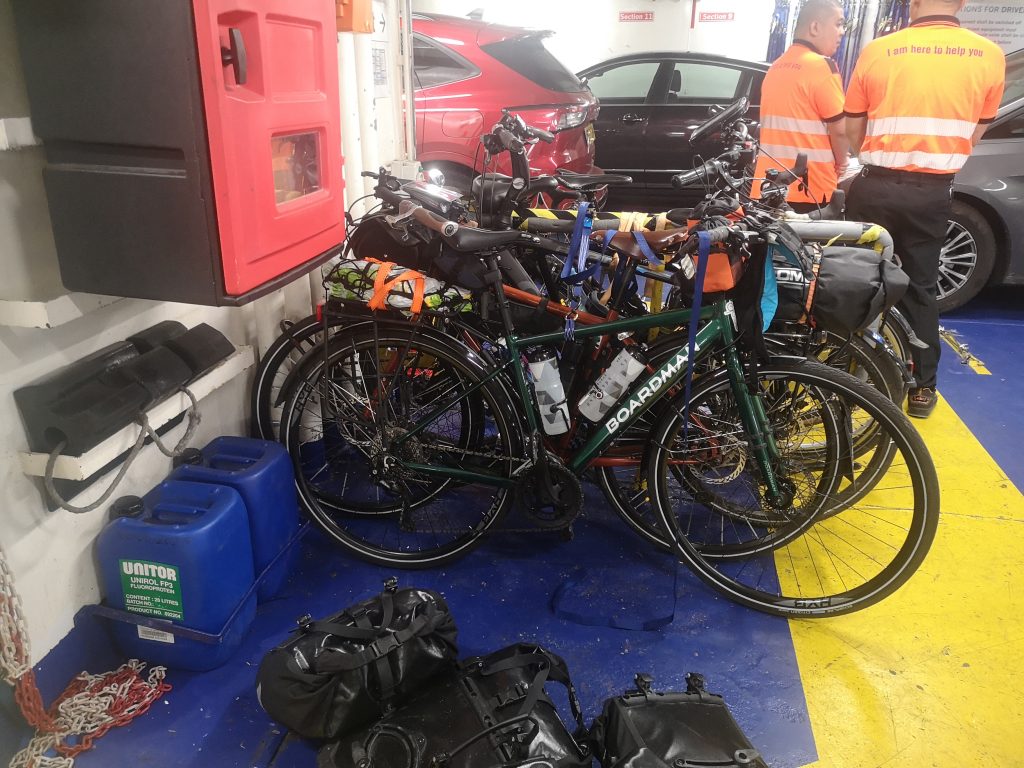
Bikes safely stowed aboard ship.
Weather
Obviously there are risks in weather terms of booking a cycling holiday around September/October, but then again there are risks in weather terms of booking a cycling holiday in high summer: who’d have fancied pedalling through the unprecedented heatwave of 30 degrees and upwards we experienced just a few months ago? Wrapped in warm, waterproof layers, I’ll take rain any day over the life-sapping temperatures we now regularly endure as summers. That being so, a few tips for waterproof gear:
- Head: Waterproof cycling cap or helmet (if you wear one) with waterproof helmet cover.
- Jacket: As waterproof and breathable as you can afford (it really is worth spending the money if you live in a rainy place and also go on holiday to rainy places!), preferably also with a hood to keep your head and neck dry. This time I wore the Madison Roam, which kept the water out but is not cut for those of us with paunches!
- Trousers: I cannot recommend strongly enough waterproof trousers that incorporate a foot cover, such as these from Decathlon, as they will also keep your shoes and ultimately feet dry.
- Shoes: Mountain bike shoes often double up nicely as touring shoes, and I’m currently wearing the Five Ten Hellcat Pro in a fetching yellow which, while not marketed as being waterproof, really did keep the wet off my socks combined with the overtrousers.
- Hands: These will get wet so I’d simply recommend some quick-drying mitts, such as these from Planet X, which did a splendid job for the price.
Ultimately, two days out of seven were rainy: day one poured down all day, day two hit us with frequent, heavy showers, and thereafter we enjoyed sunny weather with just the occasional overnight shower while tucked up in bed. So, I’d say we pretty much got away with it on the rain front!
Another climatic pitfall in the Netherlands can be the wind. Indeed, a strong headwind is known as a Dutch hill in cycling circles! Again, we were fortunate not to experience anything too extreme in that regard. We had quite a blowy day on day five, but the wind was mainly behind us, and only occasionally came from the side. The stiffest headwind was on the way from Amsterdam to Ijmuiden as we cycled back to the ferry, and that is worth taking into account if you’re planning to cycle that stretch.
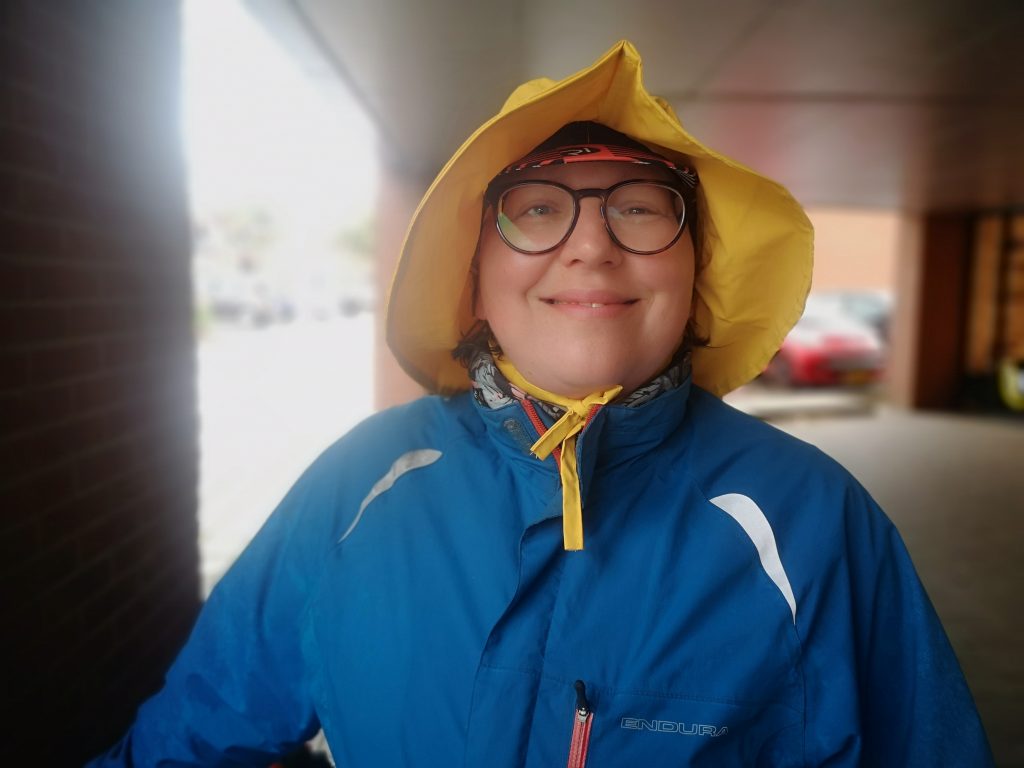
Having the right gear makes for a happy pootler!
Terrain, infrastructure and other practicalities
The terrain in this part of the Netherlands and Belgium is really, really flat. Like proper pancake flat. Any undulations are mainly human-made, such as bridges or flyovers (yes, cycle flyovers are a thing there!). So cycling is easy and leisurely with few natural obstacles such as our Pennines. What’s more, the Dutch have famously spent the last 50 years cycle-proofing their country with world-beating cycle infrastructure, so that bikes absolutely dominate the street scene across much of the Netherlands and Belgium. Of course, there are differences between the two countries: the minute we crossed the border into Belgium, the cycle lane deteriorated (slightly, but was still fine for UK standards) and life became a little more hectic. Dutch roads are intuitive as a cyclist: you always know where you need to be, where the lane is taking you, there are hardly any gaps in the network and drivers are so familiar with cyclists that they will cede priority even when they don’t have to. Belgium the same, if slightly less so. Imagine cycling around 50 miles a day for a week with no close passes, left/right hooks or road rage. Such blissful conditions alone are reason enough for making the trip.
However, nowhere is entirely perfect and the Netherlands has a few quirks we were unaware of. First: due to strict planning laws, there is very little development in rural areas. No malls/retail parks, which is a good thing, but also very few pubs, coffee shops (as in cafés, not the other kind!), sundry catering or grocery outlets along the roadside such as we’re used to here, so it can be difficult to find food as you go. Hence, as was the case on the Hebridean trip, if you see a supermarket: stock up for the day. And second, another oddity was an almost complete lack of public toilets even in towns, and given that Dutch fields tend to be separated by ditches as opposed to hedges to duck behind, there are precious few places to relieve oneself. One time we were directed to the toilets in the local police station (seriously!), and another we were permitted to use the private toilet of the off licence where we’d inquired – with some urgency – where the closest public convenience was, which is of course a secondary (often primary!) function of said absent pubs/cafés etc. I don’t really have a solution to this – some improvisation will be required!
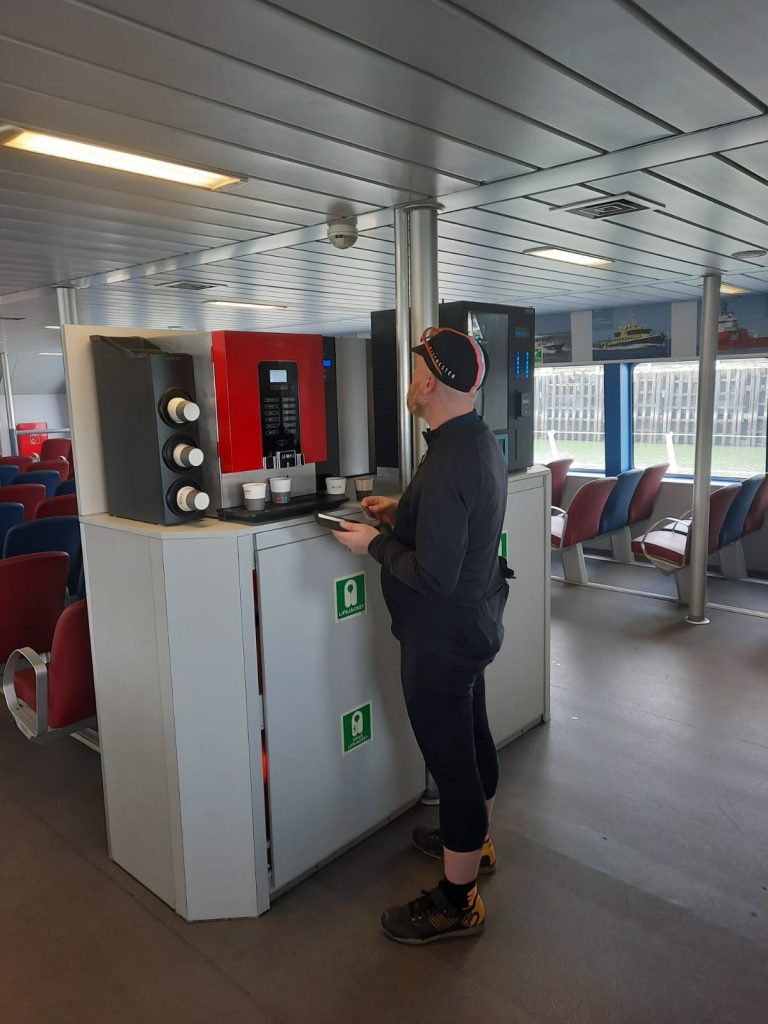
Availability of amenities varies greatly: coffee machine and a toilet on the Breskens ferry were welcomed!
Vegan food
While we’re on the subject of adequate nourishment, how well does the region cater for vegans/plant-based diets? Being in a country famous for cheese and egg-containing pancakes, the diligence and sense of exploration one develops over time came into play. The fact that Dutch supermarkets tend to sell more wholesome and less processed food helped, with Abert Heijn quickly becoming a favourite due to its availability of delicious fresh bread, soya yoghurt, fresh fruit and even a tasty vegan paté. Lunches were often eaten al fresco on (also inexplicably scarce) benches after a supermarket shop, while, with the exception of one excellent home-cooked meal we prepared in the communal kitchen at our rooms in Vrouwenpolder, we tended to eat out in the evening. As so often, Happy Cow helped us pinpoint suitable eateries: the Vegan Pizza Bar in Rotterdam, the delightful Sangeetha Indian restaurant in Antwerp, for instance. Other times it was a case of striking out and hoping for the best, such as with Street Food By Han in Delft, which did some of the best tempeh I’ve ever tasted. So vegan food isn’t as plentiful as in the UK, but with a little resourcefulness and digital assistance, we ate well.
By the way, the vegan options on the ferry were really good: enough dishes to fill a plate at least three times without too much repetition on the evening buffet and ample non-meat/egg bits of a fried breakfast plus fruit, cereal, toast, soya milk for breakfast. And all tasty to boot. Commendable.
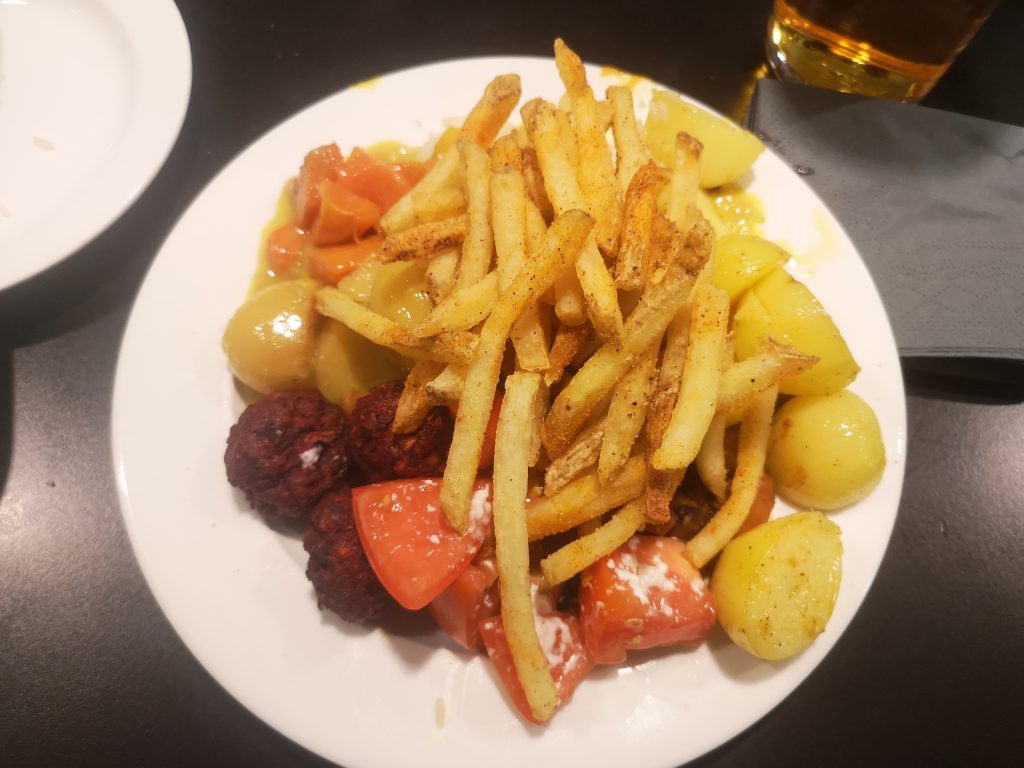
Carb-loading courtesy of the ferry’s evening buffet.
Where to stay
The Netherlands isn’t the cheapest place to find accommodation, nor the easiest – its popularity with tourists showed no sign of abating even in this post-school-holiday period. Although we wanted to stay flexible and had camping gear with us, circumstances forced our hand on a couple of occasions. The first night should have been under canvas, but after the drenching we had endured that day, we spontaneously booked a room at the a&o Rotterdam City for around £100 for the night. The Hotel Vossius in Amsterdam set us back a similar sum, while booking ahead enabled us to secure a three-person room at the St. Christopher’s Inn – The Bauhaus in Bruges for about the same (we joined up with a German chum for the second half of the week). Two delightful rooms at Hofstede Elzenoord in Vrouwenpolder cost €150 for a same-day booking. Camping was of course cheaper (but obviously weather-dependent): City Camping in Antwerp let us pitch up for €19 for a tent with two people. In booked-up Delft on the Saturday night – where the cheapest hotel rooms for three would have set us back well over €300, we were very grateful to find the charming hidden gem Natuurkampeerterrein De Grutto, which allowed three of us to stay in two tents for just over €30. Not the most ideal conditions for spontaneous route-finding and decision-making on accommodation, but we had budgeted for such eventualities so it was OK in this case. But again worth being mindful of when planning trips in future.
Life in the Low Countries
Here I will defer to Milena’s wonderful account of her impressions of the trip, which you can find here, and which she expresses with way more emotional eloquence than I am capable.
Verdict
To sum up, cycling in the Low Countries did not disappoint. The culture and the attitudes on the roads could not be more different from the UK. Having spent years prioritising bikes, the (what in the UK often appears a nebulous) aim of ensuring that short journeys are made by modes other than the car – chiefly cycling – has not only tamed the roads, it runs through the entire way of life there. Children making their own, active, independent way to school and other destinations. Town centres preserved as they are easily to reach by bike. Quiet, safe residential streets. A populace active and outside, interacting and healthy, as opposed to isolated in metal boxes as we are so often here.
Of course, the cycling infrastructure itself is breathtaking, especially for bike-infra nerds like me. The flat landscape may be somewhat featureless at times, but the experience of cycling unharassed, side by side, through the fields playing “what crop are they growing here” is truly joyful. Bike swing bridges, bike flyovers, bike tunnels, even just a safe, direct and continuous network of bike lanes proves what can be done when a country means business in the war on cars.
So: what about the Netherlands? Well, I strongly recommend you have a look for yourself. You will be amazed, surprised, overjoyed. And will definitely want to return.
We also made a video of the trip, which you can watch here:





Loved this‼️ Super cool and so helpful. Thanks
Thanks. Came across your post while waiting for the ferry to leave Harwich for Holland for a few days cycling in Holland. Planning on visiting Bruges and have just booked the hostel for a night so thanks for the recommendation.
Excellent! Have a great trip!